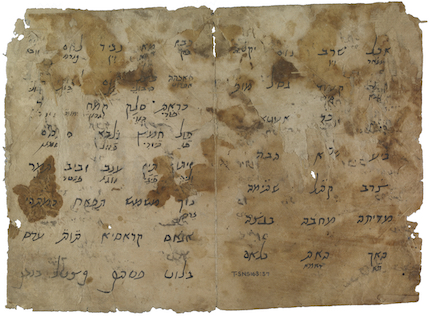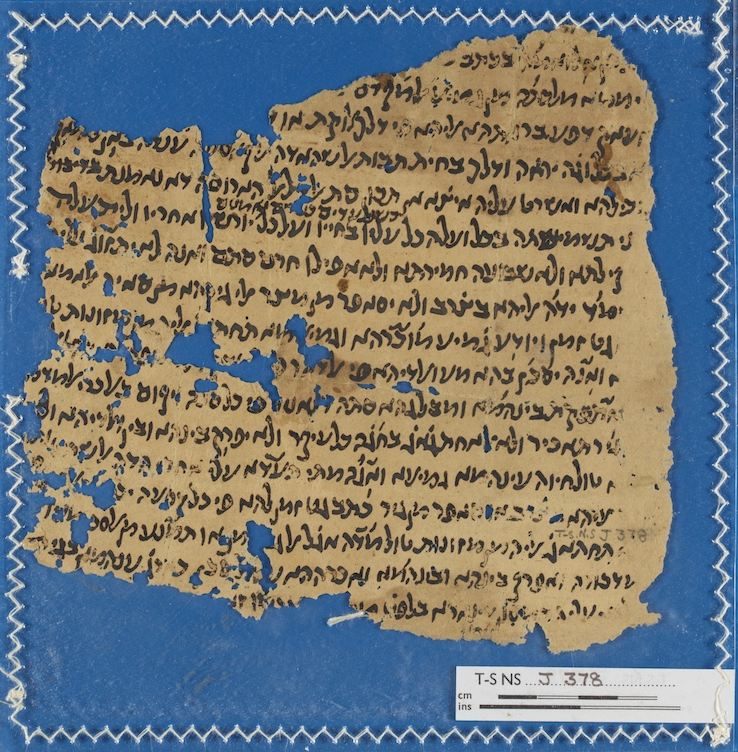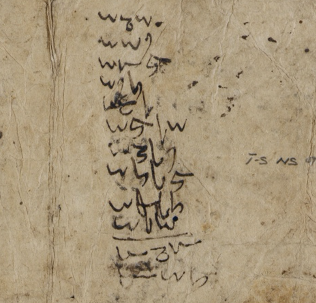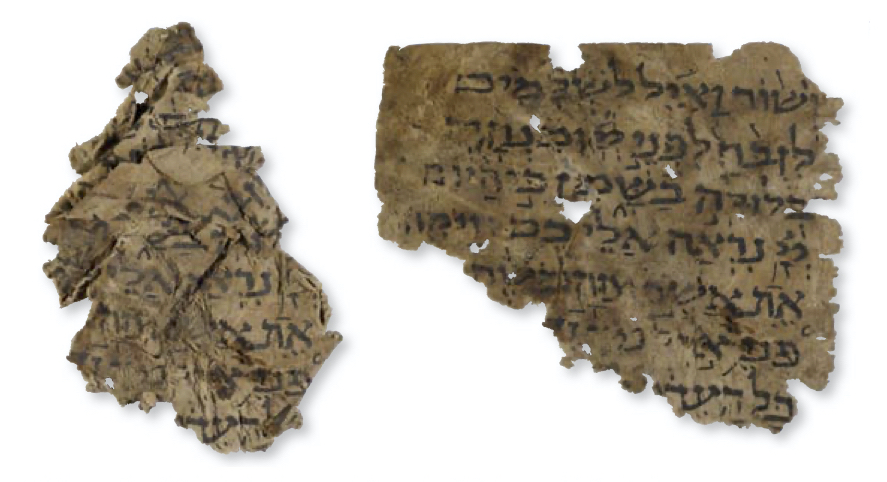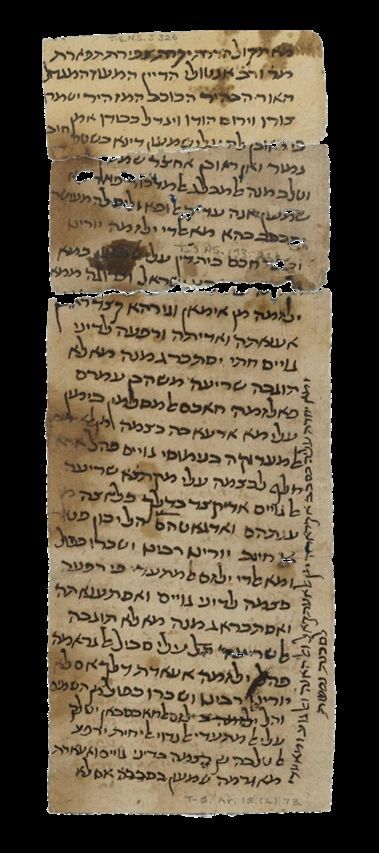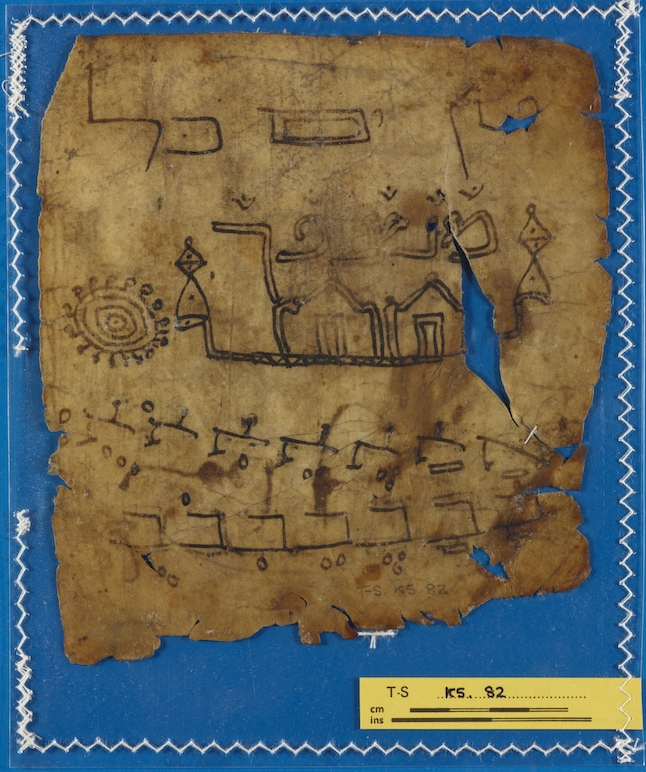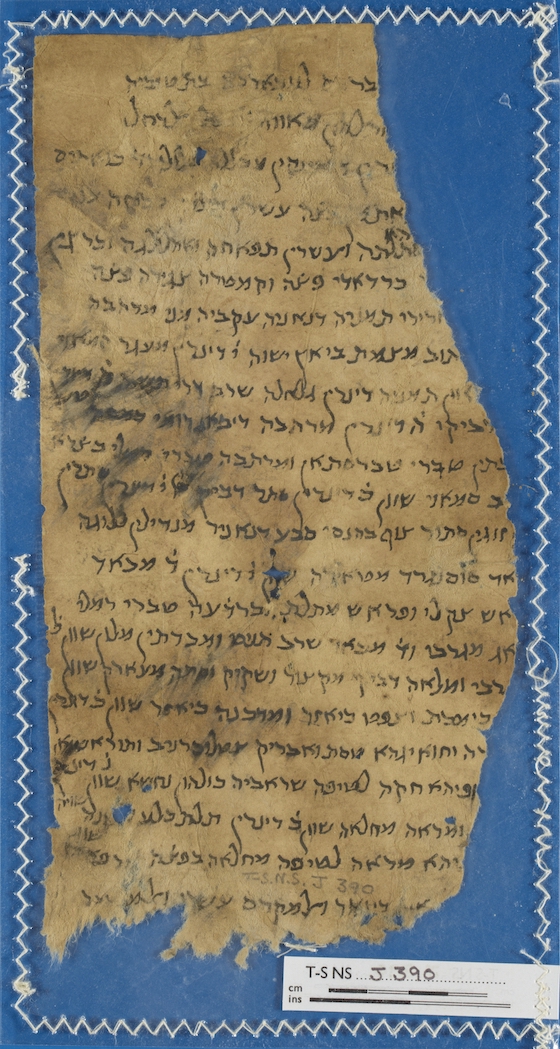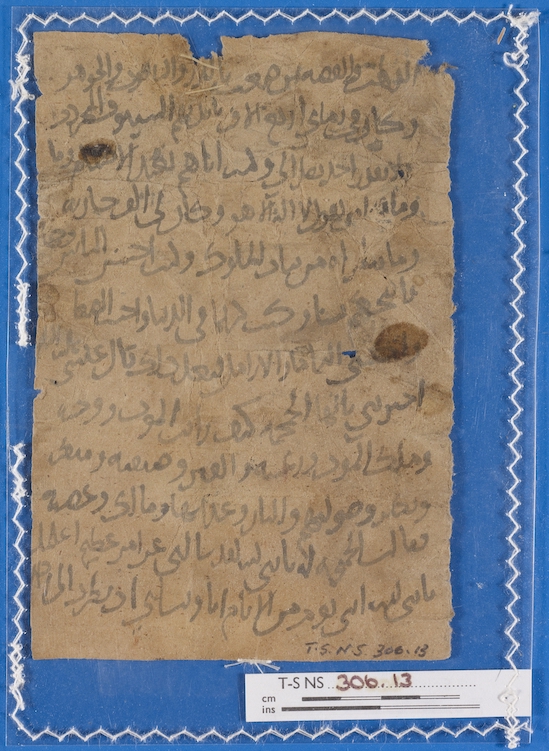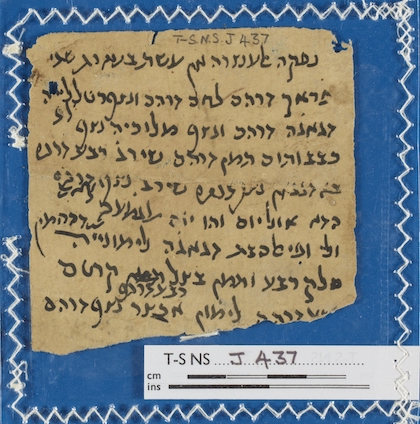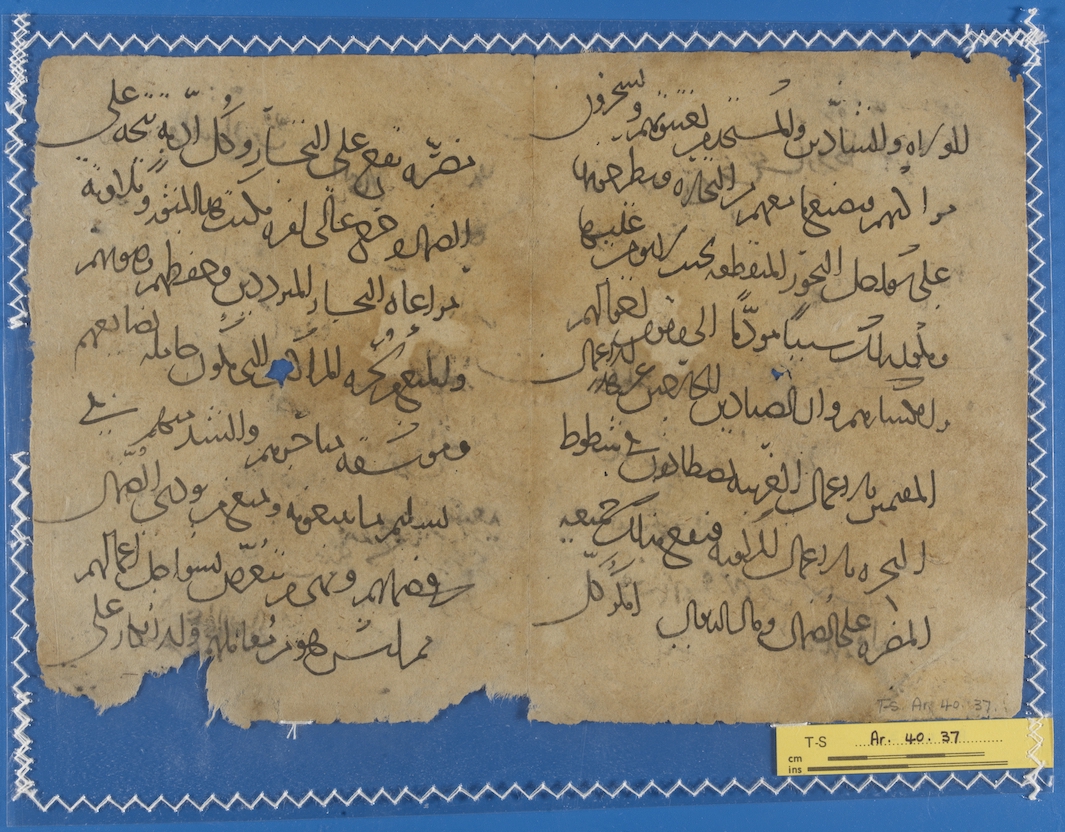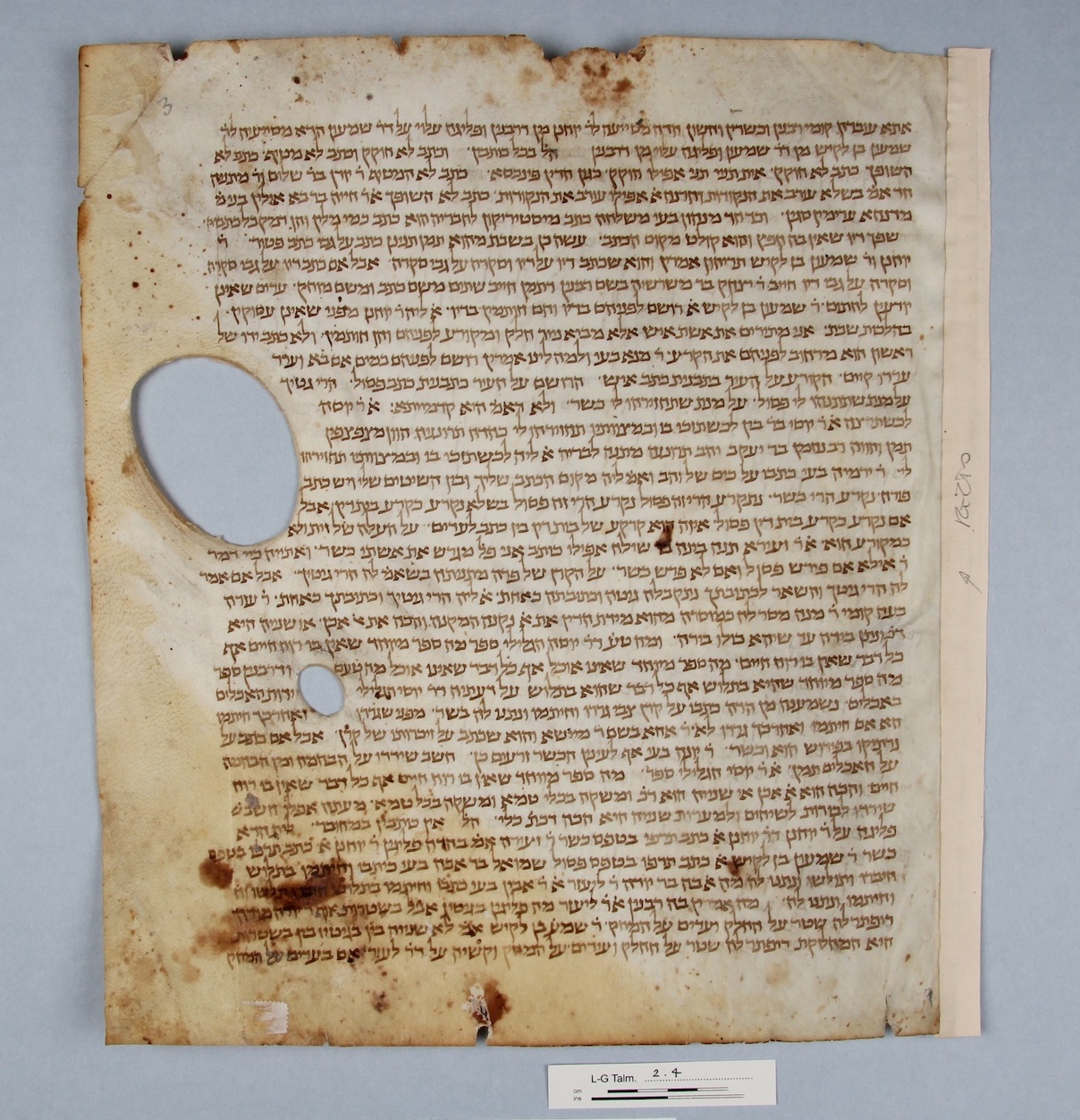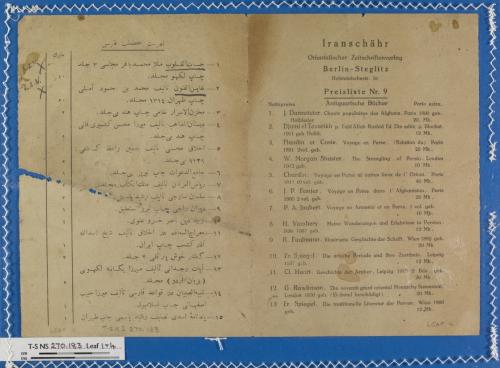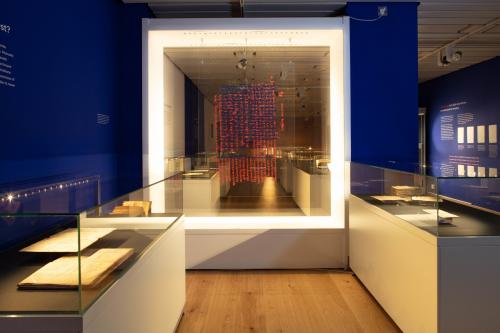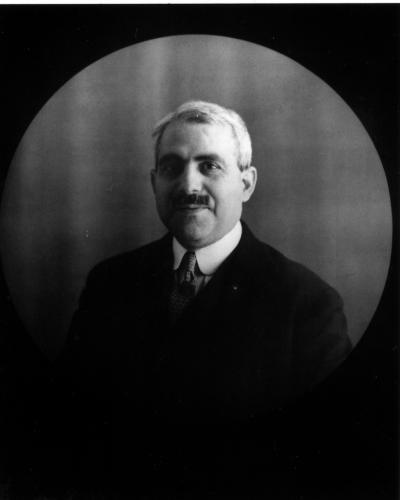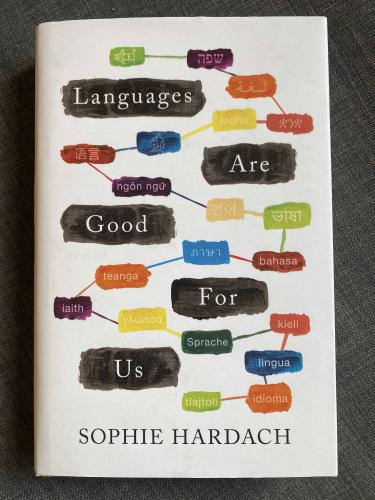T-S NS 163.57: A Judaeo-Romance/Judaeo-Arabic word list.
By Melonie Schmierer-Lee
on Thu 3 Jun 2021
Our Throwback Thursday this week is taken from issue 49 of the printed edition of Genizah Fragments, published in April 2005, by Avi Shivtiel:
A number of talmudic sages seem to have favoured the learning of languages, since the Talmud records several statements to the effect that this was a skill to be encouraged among scholars.
An early and important midrash claims that God gave the Torah to Israel in four languages - Hebrew, Latin, Arabic and Aramaic (Sifrey, Ve-Zot Ha-...
Read More...
Has tags: Armenian, Avi Shivtiel, Genizah Fragments, glossary, language, list, Romance, vocabulary
By Ben Outhwaite and Melonie Schmierer-Lee
on Wed 2 Jun 2021
So, Mel, tell me what are you working on today?
I’m writing a catalogue entry for T-S NS J378. It’s an easy one to do, because — helpfully — several other people have already translated it: Goitein, Gershon Weiss, and Amir Ashur. We still need a catalogue entry for it, though, for Cambridge Digital Library, so I’m writing that. It’s a betrothal agreement, written by our favourite court scribe, Halfon ben Manasseh. The date isn’t preserved, but because we know Halfon’s handwriting, we...
Read More...
Has tags: betrothal, Genizah Fragments, Goitein, legal, marriage, Q&A
By Magdalen M. Connolly
on Wed 2 Jun 2021
It has long been customary in both Genizah studies and Arabic codicology to describe the numerals frequently found in documentary texts as ‘Coptic’.[1] Recent work has shown that these curvilinear numerals may better be termed ḥurūf al-zimām (‘the letters of accounts/registers’) or ‘zimām numerals’ (Chrisomalis, 2010). In what follows, I will give a (very) brief overview of the Coptic alphabetic numerical system, ḥurūf al-zimām, and the related Mozarabic/Toledan and Rūmī/Fāsī numerals to explain why the Genizah Research Unit will be adopting this more accurate terminology in future...
Read More...
Has tags: accounts, Coptic, Genizah Fragments, numerals
Left: Mosseri IXa.1.28, before conservation. Right: After conservation, the Masoretic Text of Leviticus 9:4-6 is revealed.
By Melonie Schmierer-Lee
on Thu 27 May 2021
Our Throwback Thursday this week is taken from issue 63 of the printed edition of Genizah Fragments, published in April 2012, by the conservator Lucy Cheng:
Mosseri IXa.1.28 is a paper fragment, which was crumpled and exposed to dust due to less than ideal storage in the past. After testing the stability of the inks, the fragment was cleaned by gentle brushing, and encrustation of dirt or dust was broken down with pressure from a small spatula and the debris brushed away. To...
Read More...
Has tags: conservation, Genizah Fragments, Mosseri
Composite image reuniting T-S Ar.18(2).73, T-S AS 153.226 and T-S NS J326.
By Melonie Schmierer-Lee and Amir Ashur
on Wed 26 May 2021
Amir, which manuscripts are you working on today?
I'm actually working on dozens of manuscripts relating to Abraham Maimuni, as part of a project led by Mordechai Akiva Friedman. Right now, I’m looking at T-S 10K8.9, T-S 12.205, T-S 13J9.11, T-S 13J26.21 verso, T-S NS 100.74, T-S Ar.18(2).73, T-S AS...
Read More...
Has tags: Abraham Maimonides, debt, Genizah Fragments, legal, Mordechai Akiva Friedman, Q&A, responsa
T-S K5.82 (recto), one of the Genizah artworks featured in the exhibition as "The Ark and Evil Eye".
By Sarah Sykes
on Wed 26 May 2021
Scattered through the many Genizah manuscripts from the Cairo Genizah are doodles and page decorations, drawings and designs. When studying and cataloguing thousands of pages of text you will only come across these pictures on occasion, and often, if you are busy deciphering the handwriting and identifying the author, the pictures can be an interesting sideline, a bit of light-hearted amusement or only given a brief glance.
Now, however, Pinar Zararsiz, during her internship (2019-2020) at the Woolf Institute in Cambridge, has gathered together many, and a wide variety of, examples...
Read More...
Has tags: drawing, exhibition, Genizah Fragments
T-S NS J390 (trousseau list)
By Melonie Schmierer-Lee
on Thu 20 May 2021
Our Throwback Thursday this week is taken from issue 41 of the printed edition of Genizah Fragments, published in April 2001, by Erica C.D. Hunter and Friedrich Niessen:
In 1980, in the fourth volume of A Mediterranean Society, page 467, S. D. Goitein noted that T-S NS J390 (23.5 x 11.7 cms) and T-S 13J7.8 (27.4 x 6.5 cms) could...
Read More...
Has tags: Christian, dowry, Genizah Fragments, Goitein, marriage, Peshitta, Syriac, trousseau
By Melonie Schmierer-Lee and Magdalen Connolly
on Wed 19 May 2021
Magdalen - which manuscript are you working on today?
This morning I’m working on fragments from the T-S NS 305 and NS 306 sections of the collection, which contain mainly Arabic-script material of a wide variety of genres. In particular, I’ve been looking at an Arabic-script fragment (T-S NS 306.13), which contains part of Qiṣṣat al-Jumjuma (‘The Story of the Skull’). This story is found fairly frequently in the Cairo Genizah collections in Judaeo-Arabic (e.g., T-S Ar.37.39 and JTS ENA 1275.5, 12, 13, ENA 2700.48, and ENA 3239.34). This fragment is particularly...
Read More...
Has tags: Arabic, Genizah Fragments, literary, Q&A, tale
By Melonie Schmierer-Lee
on Fri 14 May 2021
The items in this shopping list reveal the careful planning and budgeting needed to celebrate the festival of Shavuot in style. First published by S.D. Goitein (Med. Soc IV, pp. 230-231), this fragment (T-S NS J437) dates to the 13th century, and may have been written by the court scribe Solomon b. Elijah. It includes (for Friday): little chickens, meat, a pound of fat tail, a hen, garden mallow, cubeb and garlic, two measures of sesame oil, eggplants; and (for Saturday): a lemon hen, chard, onions, safflower...
Read More...
Has tags: Genizah Fragments, Goitein, Shavuot
By Melonie Schmierer-Lee
on Thu 13 May 2021
Our Throwback Thursday this week is taken from issue 13 of the printed edition of Genizah Fragments, published in April 1987:
In the course of editing a corpus of mediaeval Arabic legal and chancery documents preserved in the Cambridge Genizah Collection, Dr Geoffrey Khan, Research Assistant in the Genizah Unit, has discovered a decree on the subject of fishing rights.
The decree was issued by the Fatimid government of Egypt in the twelfth century and is intended to protect...
Read More...
Has tags: al-Hafiz, Chancery, Fatimid, fishing, Genizah Fragments, Geoffrey Khan
By Melonie Schmierer-Lee
on Thu 13 May 2021
125 years ago today, Solomon Schechter sat down to write to Agnes Lewis. His quick note dashed off ‘in haste and great excitement’ told her that he’d managed to identify one of her recently purchased manuscripts as the original Hebrew text of the book of Ecclesiasticus (Ben Sira or Sirach). It had been preserved in Greek, Syriac and other translations, but the Hebrew original was lost and its very existence was doubted by many scholars who thought the book had originally...
Read More...
Has tags: Adolf Neubauer, Agnes Lewis, Arthur Cowley, Ben Sira, Bodleian, Ecclesiasticus, Genizah Fragments, Jerusalem Talmud, Lewis-Gibson, Margaret Gibson, Solomon Schechter
T-S NS 270.183: A German price list for Arabic and Persian books, printed in 1929.
By Melonie Schmierer-Lee and Nick Posegay
on Wed 12 May 2021
Q&A Wednesday gives a short interview with a Genizah researcher: what are they working on today? And why?
Nick, what are you working on this week?
Lately I’ve been working on late-dated manuscripts in Genizah collections. Looking at fragments dated after 1864, trying to work out how they ended up in genizot, and thinking about what that means for “Cairo Genizah” collections as we typically understand them.
Have you found many fragments that are dated that late?
I’ve found about 25 that are explicitly dated, but I suspect...
Read More...
Has tags: Agnes Lewis, Genizah Fragments, Greville Chester, ketubba, Margaret Gibson, printed, Q&A, Solomon Schechter, Yemen
Ghost Words: A new exhibition from Cambridge University Library
By Ben Outhwaite
on Wed 12 May 2021
With the relaxing of Covid restrictions on museums and galleries from the middle of May, I’m pleased to report that ‘Ghost Words’ will finally be open to visitors, six days a week from 24th May. Booking is essential, however, as restrictions have been relaxed but not entirely removed. For more information on what to expect and how to book go to:
https://www.lib.cam.ac.uk/ghostwords
‘Ghost Words’ brings together a plethora of CUL’s most important palimpsest manuscripts, and, as you might expect, this includes a...
Read More...
Has tags: exhibition, Genizah Fragments, Ghost Words, Hexapla, Origen, palimpsest, Yannai
By Ben Outhwaite
on Fri 7 May 2021
The Jacques (or Jack) Mosseri Collection arrived in Cambridge in 2006. After Schechter brought his famed hoard to Cambridge, Mosseri, a prominent member of Egypt’s Jewish community with a keen interest in its history, and knowing that other manuscripts had been buried, set about retrieving these from various places. Following his death, and with his family leaving Egypt, scholars lost track of the collection, but it re-emerged in the...
Read More...
Has tags: bulla, Dunash b. Labrat, Genizah Fragments, Gershom, Isaac Luria, Moses Maimonides, Mosseri, podcast, Stefan Reif
Languages Are Good For Us (Head of Zeus, 2021)
By Melonie Schmierer-Lee
on Thu 6 May 2021
Languages Are Good For Us ● By Sophie Hardach ● Head of Zeus, 2021
Fustat’s multilingual community and the practice of stashing away sacred but worn out manuscripts make an appearance in novelist and former Reuters journalist Sophie Hardach’s new book, Languages Are Good For Us (2021). The book, written for a general audience interested in ‘the strange and wonderful ways in which humans have used languages’ is bursting with fascinating stories, ranging from cuneiform tablets, Linear B, the activities of medieval monks, and trading languages, to fairy...
Read More...
Has tags: Book, Genizah Fragments, language

